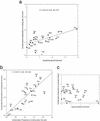Protein-protein interactions: structurally conserved residues distinguish between binding sites and exposed protein surfaces
- PMID: 12730379
- PMCID: PMC156276
- DOI: 10.1073/pnas.1030237100
Protein-protein interactions: structurally conserved residues distinguish between binding sites and exposed protein surfaces
Abstract
Polar residue hot spots have been observed at protein-protein binding sites. Here we show that hot spots occur predominantly at the interfaces of macromolecular complexes, distinguishing binding sites from the remainder of the surface. Consequently, hot spots can be used to define binding epitopes. We further show a correspondence between energy hot spots and structurally conserved residues. The number of structurally conserved residues, particularly of high ranking energy hot spots, increases with the binding site contact size. This finding may suggest that effectively dispersing hot spots within a large contact area, rather than compactly clustering them, may be a strategy to sustain essential key interactions while still allowing certain protein flexibility at the interface. Thus, most conserved polar residues at the binding interfaces confer rigidity to minimize the entropic cost on binding, whereas surrounding residues form a flexible cushion. Furthermore, our finding that similar residue hot spots occur across different protein families suggests that affinity and specificity are not necessarily coupled: higher affinity does not directly imply greater specificity. Conservation of Trp on the protein surface indicates a highly likely binding site. To a lesser extent, conservation of Phe and Met also imply a binding site. For all three residues, there is a significant conservation in binding sites, whereas there is no conservation on the exposed surface. A hybrid strategy, mapping sequence alignment onto a single structure illustrates the possibility of binding site identification around these three residues.
Figures





References
Publication types
MeSH terms
Substances
Grants and funding
LinkOut - more resources
Full Text Sources
Other Literature Sources
Miscellaneous

